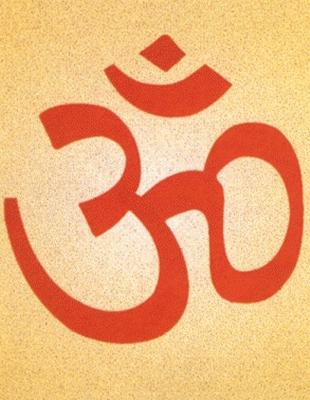| |
The
Absolute
AUM
(OM, OHM) within Hinduism symbolizes the unborn non-dualistic, omnispresent,
impersonal Absolute, which incoperates all forms of life; which is life.
The sacred AUM symbol above represents both the unmanifest, nirguna,
and manifest, saguna, aspects of the Absolute. By sound and form,
AUM symbolizes the infinite Brahman* (ultimate reality).
- A
stands for Creation
-
U stands for Preservation
- M
stands for Destruction or dissolution
This is
representative of the Trinity of God in Hindu dharma (Brahma,
Vishnu and Shiva)
SOME
INTERRELIGIOUS BACKGROUNDS
(You
can also download the first part of this article in PDF)
AUM,
the 'Sound of Light'
In
Hindu scriptures, in the Vedas, AUM is the 'Sound of the Sun',
the 'Sound of Light'.
Muslims call it Saut-I-Sarmadi, the Unstruck Melody, or
Kalma, meaning 'Word' like mentioned in St.
John 1:1-4. Sikhs call it Shabd. Tibetan Buddhists
call it bden tshig. Every religion has equivalents for OM.
AUM (Om, Ohm) manifests via light and sound when one converts the scattered
outer attention and focus single minded at the eye centre. The dot,
the third eye, between the eye brows on both Hindu and Buddhist statues
is referring to this door of inner perception which can be entered direct
or via meditation. Hearing the inner sound (bhajan) and seeing
the inner light (dhyan) is a common theme in mystic literature
of all religions. (See also St.
Matthew 6:22).
Buddha on the 'Sound of Light'
In Buddhism the inner light is considered a manifestation of the intrinsic
Buddha nature of all men. Also the Buddha teached listening to the Sound
of Light. In the Mahasakuludayi Sutta (77:32 |Nanamoli
& Bodhi translation p. 644) Buddha says:
"Again, Udayin, I have proclaimed to my disciples the way whereby
with the divine ear element [dibbasota], which is purified and surpasses
the human, they hear both kind of sounds, the divine and the human,
those that are far as well as near (…) And thereby many disciples
of mine abide having reached the consummation and perfection of direct
knowledge."
(See also St.
Matthew 13:13-17.)
In the Surangama Sutra (PDF-version
p. 203-212) listening to sound is considered the most beneficial method
of meditation "for men of various kind". (On an individual
bases other methods can be more suitable).
"To
hear your very Self, why not turn backward
That faculty employed to hear Buddha's words
Hearing is not of itself,
But owes its name to sound.
Freed from sound by turning hearing backwards,
What do you call that which is disengaged
When one sense organ has to its source returned,
All the six senses thereby are liberated.
(...)
Ananda and all you who listen here
Should inward turn your faculty
Of hearing to hear your own nature
Which alone achieves Supreme Bodhi.
That is how enlightenment is won.
Buddhas as many as the Ganges' sand
Entered this one gateway to Nirvana.
All past Tathagatas
Have achieved this method.
All Bodhisattvas now
Enter this perfection.
All who practise in the future
On this Dharma should rely."
Practise
According to both Hindu and Buddhist scriptures before starting any spiritual
practise above all one first need to find a spiritual friend, an accomplished
guru of a lineage of gurus of good reputation, with whom one has a (karmic)
connection and who is alive; 'in the flesh'. See for instance the Buddhist
Words of My Perfect Teacher, or and the Hindu The
Spiritual Master and the Disciple.
In the past Buddhist Masters taught 'to listen to the listener', like
the fourteenth century Japanese Zen Master Bassui (See Mud
& Water p. 159-164). Within Tibetan Buddhism the teachings
of Guru Buddhapada are an example of focussing on Unstruck Sound
(See Masters
of Mahamudra p.91-93). Unfortunetly in 2007 there are hardly any
Buddhist Masters [accessible for the main public] who are teaching this
way of listening as a main practise. However meditation of 'hearing your
very Self' of the Surangama Sutra is - although not wrapped in
Buddhist terms - still taught to at the interreligious ashram Dera
Baba Jaimal Singh at Beas -also known as Radha Soami Satsang
Beas - in the Punjab, India.
In
spite of using traditional Hindu terms to explain Dharma, the
core of the teachings of the lineage of gurus at Dera Baba Jaimal
Singh are close to the core of the teachings of the Buddha. H.E.
Chogye Trichen Rinpoche, teacher of H.H. Dalai Lama XIV comfirmed
this by declaring while seeing a picture of the most famous master of
this ashram, Sant
Satguru Baba Sawan Singh Ji Maharaj (1858-1948): "This Great
Yogi walked a Hindu Tantrayana path which is almost identical to Buddhist
Tantrayana."
**
The path Rinpoche referred to is the path of Surat Shabd Yoga.
And up till today the current lineage holder and great grandson
of Baba Sawan Singh Ji, Gurinder Singh Ji- also known as Baba Ji of
Beas - still initiates people of all faith in this Dharma of
hearing OHM, The Gateway
to Nirvana of
which Buddhist and Hindu scriptures speak.
____________
* With 'n' (Brahma, without 'n', is, as mentioned, part of the Hindu
trinity, Brahma, Vishnu
en Shiva.)
** H.E. Chogye Trichen Rinpoche made this clear statement to MFI
President André Kalden during Losar (Tibetan New Year)
2003 at Boudhanath, Nepal. Rinpoche underlined his words with a gesture
pointing out two ways going closely and almost parallel, heading in
the same direction. In the above mentioned context Rinpoche used the
label Tantrayana as opposed to Sutrayana.
 Back to your previous page
Back to your previous page
Annapurna
- Muktinath
Map - Muktinath
History -
Muktinath Lama Wangyal - Travel
Info - Nuns
- Picture
Gallery -
Site Map- MFI
Recommendations
Support
us with a donation

|
|



